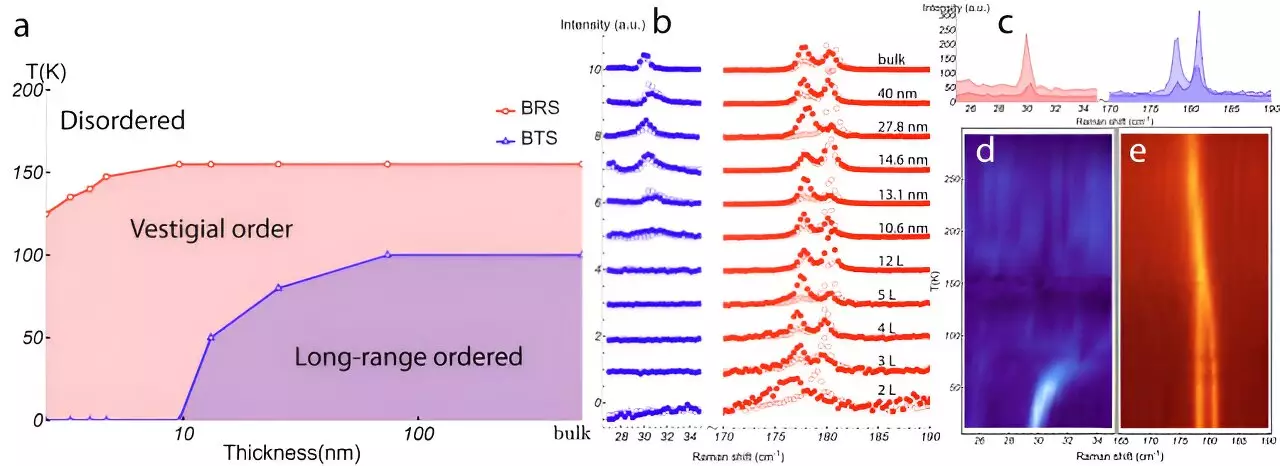A cooperative effort among researchers from The University of Hong Kong, Texas Tech University, and the University of Michigan has led to a remarkable breakthrough in the domain of van der Waals (vdW) magnetic materials. This unique class of materials is renowned for its distinct electronic and magnetic properties, attracting significant interest for applications ranging from advanced electronics to energy storage systems. The recent findings, documented in the prestigious journal *Nature Physics*, mark the first experimental observation of a transition in nickel phosphorus trisulfide (NiPS3) from a three-dimensional (3D) magnetic order to a two-dimensional (2D) vestigial order state. Such research opens the door to a deeper comprehension of how these materials can be manipulated at the nanoscale to enhance technological advancements.
In their study, the physicists meticulously analyzed how the magnetic characteristics of NiPS3 evolve when the material is reduced to fewer layers. The implications of this discovery could potentially revolutionize technologies, leading to the creation of more efficient electronic devices and high-capacity data storage solutions that consume less energy. The practical applications of controlling magnetic properties at such small scales would profoundly impact the field of computing, facilitating innovative designs for low-energy devices that align with the growing demand for eco-friendly technology.
The quest for understanding layered structures in nanotechnology finds its roots in the pioneering ideas proposed by Richard Feynman during his 1959 lecture, “Plenty of Room at the Bottom.” Although his queries regarding the potential applications of nanoscale manipulation largely went unaddressed for decades, they resurfaced in the context of contemporary research involving van der Waals materials. The emergence of compounds like NiPS3 illustrates how scientists are now actively exploring the nuances of thickness and dimensionality in materials, taking strides toward fulfilling Feynman’s foresight.
NiPS3 stands out due to its intriguing magnetic behavior when thinned to a few layers or even a single layer, making it an ideal candidate to study how its properties evolve. This accessibility of layered materials invites researchers to conduct experiments that unravel the critical behaviors inherent to these substances, showcasing their potential for diverse applications.
An essential concept in condensed matter physics is the examination of phase transitions—how materials shift between distinct states due to variations in their properties, such as temperature or dimensionality. The research team focused on the phenomenon of symmetry breaking, particularly in the context of NiPS3. Observations indicated an intermediate stage of symmetry breaking leading to a vestigial order. This term, reflecting remnants of pre-existing traits amid an evolutionary process, aptly describes the retention of certain features during the transition from a primary magnetic magnetic state to a simpler two-dimensional format.
The vestigial order in this research manifests as the Z3 Potts-nematicity, revealing how hierarchical arrangements in magnetic materials can persist even as their fundamental order dissolves. Traditional symmetry breaking entails complete loss of symmetry; however, the distinction of vestigial order allows for the preservation of some symmetries, presenting a unique insight that challenges conventional understanding.
To explore the nuances of vestigial order, the researchers employed advanced techniques such as nitrogen-vacancy (NV) spin relaxometry and optical Raman quasi-elastic scattering. These methodologies facilitated the characterization of magnetic state transitions within NiPS3, illuminating the melting process that coincides with a decrease in thickness. The study further involved large-scale Monte Carlo simulations, utilized to visualize the magnetic phases in bilayer NiPS3, unveiling a pathway to identify the crossover phenomenon culminating in vestigial order emergence.
This layered investigation not only advances our comprehension of 2D versus 3D physics, but it also solidifies the foundational principles for manipulating electronic materials at the nanoscale. Such efforts serve as a definitive step toward addressing Feynman’s inquiry about layered structures and their transformative potential.
Looking ahead, the implications of this research extend well beyond theoretical understanding. The exploration of layered materials, including NiPS3 and related compounds, presents an enticing avenue for developing state-of-the-art electronic devices. With promising characteristics such as high performance, low power consumption, and flexibility, these materials signal a movement toward producing ultradense, energy-efficient, and adaptable two-dimensional logic and memory circuits.
As researchers continue to delve into the complexities of materials like NiPS3, we are moving closer to realizing Feynman’s once-ambiguous vision of finely-tuned layered materials. Such advancements will not only propel technological progress but may also redefine our understanding of material science, opening new realms of possibility in various active fields. Indeed, the research on van der Waals materials such as nickel phosphorus trisulfide embodies the spirit of innovation, illustrating how fundamental studies can lead to remarkable breakthroughs in technology.


Leave a Reply